It’s no secret that travel opens doors, allowing us to witness firsthand the pinnacle of human creativity and expression. It’s an invitation to step into the worlds created by the greatest artists of all time, to stand before their masterpieces, and to feel the power of their vision. The cities that shelter these iconic paintings are the custodians of some of humanity’s greatest treasures.
For those who wander with a passion for art, the opportunity to see these masterpieces in person is irresistible. Visiting these cities and their revered galleries provides a chance to connect with the artists and their eras, to understand the contexts that shaped these works, and to appreciate the enduring impact they have on our culture today. It’s a reminder of the transformative power of art, encouraging us to see the world, and perhaps ourselves, through a different lens.
Mona Lisa (1503), Leonardo da Vinci — Louvre Museum, Paris, France

Mona Lisa, Musee du Louvre, Paris by jivedanson licensed under CC BY-NC-SA 2.0 DEED
The Mona Lisa, painted by Leonardo da Vinci in the early 16th century, holds a place of honor in the Louvre Museum, Paris. Often surrounded by a throng of admirers, this enigmatic portrait continues to captivate visitors with its subtle smile and the mysterious gaze that seems to follow you around the room. The mastery of da Vinci’s technique, from the soft sfumato that blends the colors to the detailed background that stretches into an almost dreamlike landscape, showcases why this painting remains one of the most celebrated works of art in the world. And, in the presence of the Mona Lisa, you have an opportunity to connect across centuries with one of the most brilliant minds of the Renaissance.
While You’re There: The Louvre is a treasure trove of art beyond the Mona Lisa. Just a short walk away, find yourself in front of Liberty Leading the People by Eugène Delacroix. This vibrant symbol of freedom and revolution stirs the soul with its dynamic composition and the fierce determination in the eyes of its subjects. Nearby, The Raft of the Medusa by Théodore Géricault offers a stark contrast with its harrowing depiction of human desperation and survival.
Starry Night (1889), Vincent van Gogh — Museum of Modern Art, New York City

Starry Night, by Vincent van Gogh 1889 by Rosa Say licensed under CC BY-NC-ND 2.0 DEED
Starry Night by Vincent van Gogh, housed in the Museum of Modern Art (MoMA) in New York City, is a whirlwind of emotional intensity and raw beauty captured on canvas. Painted in 1889, this masterpiece transcends the traditional portrayal of the night sky, presenting it as a living, breathing entity. Van Gogh’s swirling, vibrant night sky filled with luminous stars and the quiet village below speaks to the profound emotions and inner turmoil that marked the artist’s life. The bold, dynamic strokes and the vivid palette invite viewers into a world where emotion and expression are unbound by the constraints of reality.
While You’re There: MoMA’s collection is an embarrassment of riches, offering more than just one iconic piece. Close to Starry Night, you can delve into the surreal with Salvador Dalí’s The Persistence of Memory, a fascinating exploration of time that challenges the viewer’s perception of reality. Not far, Pablo Picasso’s Les Demoiselles d’Avignon marks a radical break from traditional composition, ushering in the era of modern art with its fragmented forms and stark portrayal of its subjects.
The Last Supper (1498), Leonardo da Vinci — Convent of Santa Maria delle Grazie, Milan, Italy

Leonardo, Last Supper by Steven Zucker licensed under CC BY-NC-SA 2.0 DEED
Leonardo da Vinci’s The Last Supper, a monumental fresco in Milan‘s Convent of Santa Maria delle Grazie, revolutionizes the traditional depiction of this biblical scene. Completed in 1498, da Vinci introduces a level of human emotion and dynamism previously unseen. The arrangement of the figures, the expressions of suspense, bewilderment, and dismay among the apostles, and the use of perspective draw viewers directly into the moment Christ announces one of them will betray him. This masterpiece not only showcases Leonardo’s unparalleled ability to convey narrative and emotion but also his innovative techniques that have influenced art for centuries.
While You’re There: Milan offers more artistic treasures a short distance from The Last Supper. The Pinacoteca di Brera is home to The Marriage of the Virgin by Raphael, a masterpiece of balance and beauty. Additionally, the Poldi Pezzoli Museum’s Madonna of the Book by Sandro Botticelli provides a serene and intimate portrayal of the Madonna.
Guernica (1937), Pablo Picasso — Reina Sofia Museum, Madrid, Spain
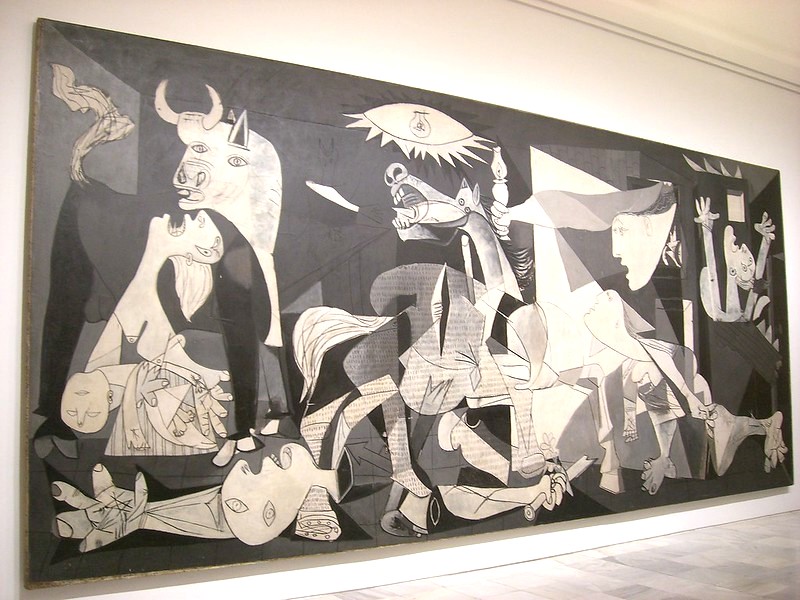
Guernica, Picasso, Museo Nacional Centro de Arte Reina Sofía, Madrid by Peter Collins licensed under CC BY-SA 2.0 DEED
Pablo Picasso’s Guernica, displayed in Madrid‘s Reina Sofia Museum, stands as a powerful testament to the horrors of war and the universal desire for peace. Created in 1937 in response to the bombing of the Basque town of Guernica during the Spanish Civil War, this monumental canvas is a chaotic and emotive depiction of the agony and devastation wrought by conflict. Picasso’s use of monochromatic tones enhances the drama and intensity, making the suffering almost palpable. Guernica challenges viewers to confront the impact of violence and the enduring relevance of its message against war.
While You’re There: Nearby, the Prado Museum offers a journey through different epochs of art. Don’t miss the Garden of Earthly Delights by Hieronymus Bosch, a fantastical and intricate portrayal of human vice and virtue. Las Meninas by Diego Rodriguez de Silva y Velazquez, with its complex composition and perspective, invites you into the heart of the Spanish court, providing a stark contrast to the modernist critique found in Guernica.
The Scream (1893), Edvard Munch — National Gallery, Oslo, Norway
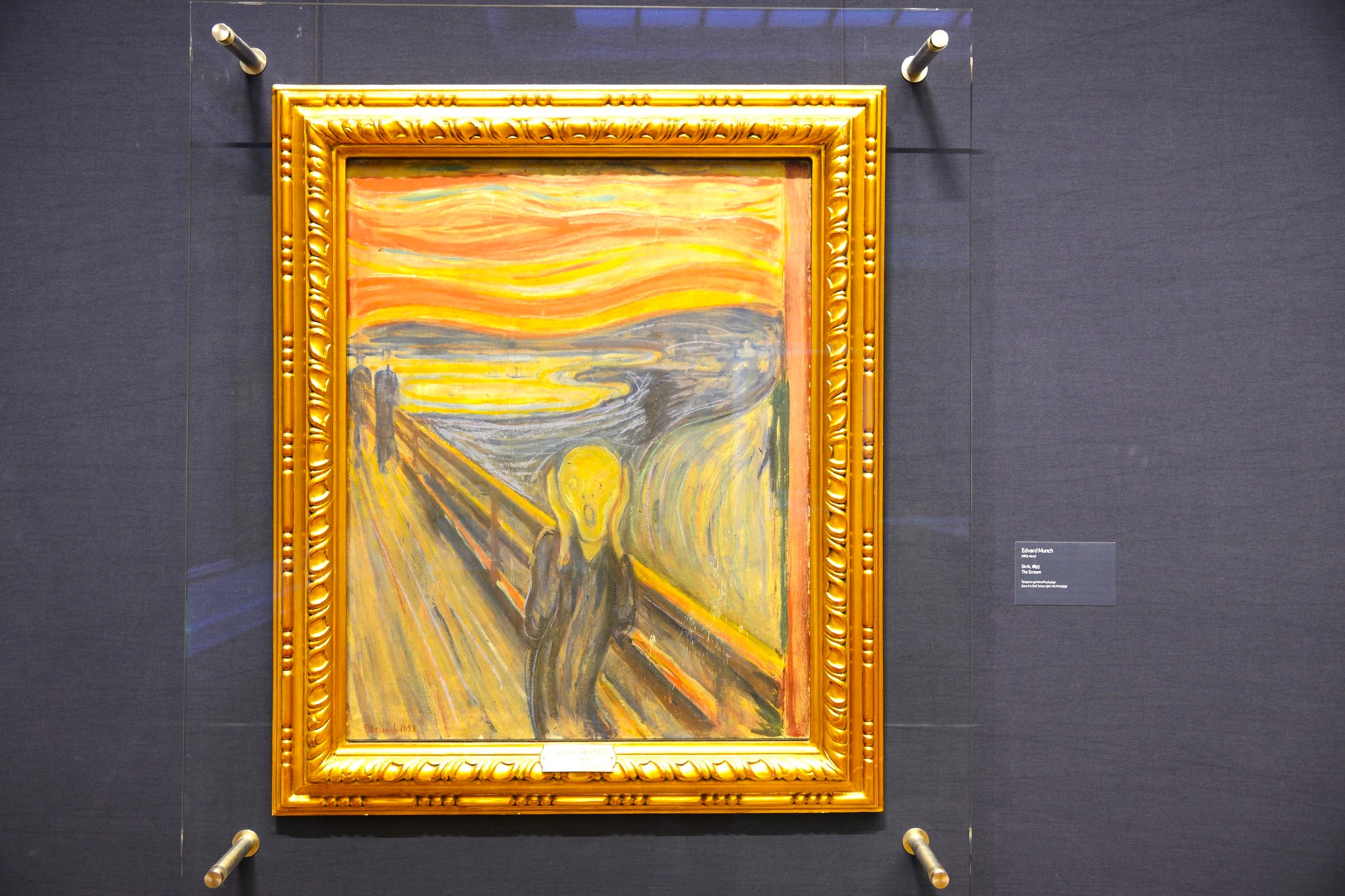
The Scream, Edvard Munch by Jorge Láscar licensed under CC BY 2.0 DEED
Edvard Munch’s The Scream, housed in Oslo‘s National Gallery, captures the essence of existential angst and the universality of human anxiety. Painted in 1893, this iconic image of a figure standing against a backdrop of a blood-red sky, hands clamped over ears, mouth agape in a silent scream, transcends its moment to speak to the universal experience of dread. Munch’s use of vibrant colors and fluid lines conveys a sense of turmoil and unrest, making The Scream a powerful symbol of emotional intensity and human vulnerability.
While You’re There: The Munch Museum, dedicated to the artist’s extensive body of work, offers a deeper dive into Munch’s exploration of life, love, and death. Don’t miss the haunting beauty of Madonna and the evocative narrative of The Dance of Life.
The Birth of Venus (1486), Sandro Botticelli — Uffizi Gallery, Florence, Italy

The Birth of Venus, Sandro Botticelli, Florence, Italy by Huang Chao licensed under CC BY-NC-ND 2.0 DEED
Sandro Botticelli’s The Birth of Venus, housed in Florence‘s esteemed Uffizi Gallery, is a mesmerizing portrayal of beauty, mythology, and Renaissance ideals. Completed in 1486, this painting captures the moment of Venus’s emergence from the sea, standing on a shell, symbolizing love and beauty’s divine origin. Botticelli’s mastery in depicting the fluidity of form and the ethereal quality of Venus, set against a dreamlike landscape, exemplifies the Renaissance’s fascination with classical mythology and the human figure’s idealization.
While You’re There: The Uffizi Gallery is home to other Renaissance masterpieces, including The Annunciation by Leonardo da Vinci, showcasing his mastery of perspective and form. Also, don’t overlook Michelangelo’s Doni Tondo, a stunning example of the artist’s skill in capturing the human form and emotion.
Girl with a Pearl Earring (1665), Johannes Vermeer — Mauritshuis, The Hague, Netherlands
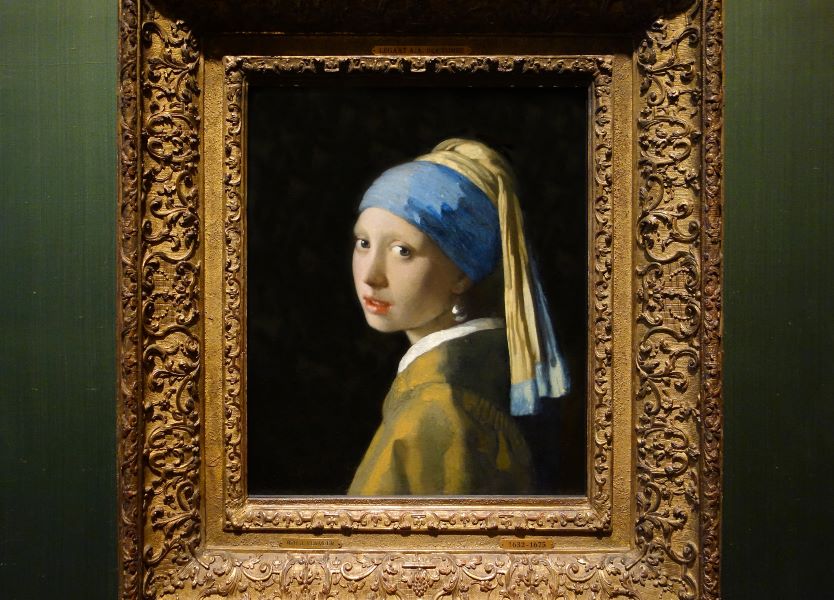
Girl with a Pearl Earring, Johannes Vermeer by Steven Zucker licensed under CC BY-NC-SA 2.0 DEED
Johannes Vermeer’s iconic Girl with a Pearl Earring, a jewel in the Mauritshuis museum in The Hague, is often heralded as the Dutch Mona Lisa. Painted in 1665, this captivating work is celebrated for its simplicity and the mysterious allure of the young woman depicted. Vermeer’s masterful use of light and shadow, the luminescent quality of the girl’s skin, and the mesmerizing gaze that engages the viewer, create an intimate and timeless portrait. The eponymous pearl earring, a spot of luminous beauty, draws the eye, symbolizing the allure and depth of the painting’s subject.
While You’re There: The Mauritshuis houses other masterpieces of the Dutch Golden Age, including The Anatomy Lesson of Dr. Nicolaes Tulp by Rembrandt. This painting offers a fascinating look into the era’s scientific curiosity and artistic excellence.
The Night Watch (1642), Rembrandt van Rijn — Rijksmuseum, Amsterdam, Netherlands
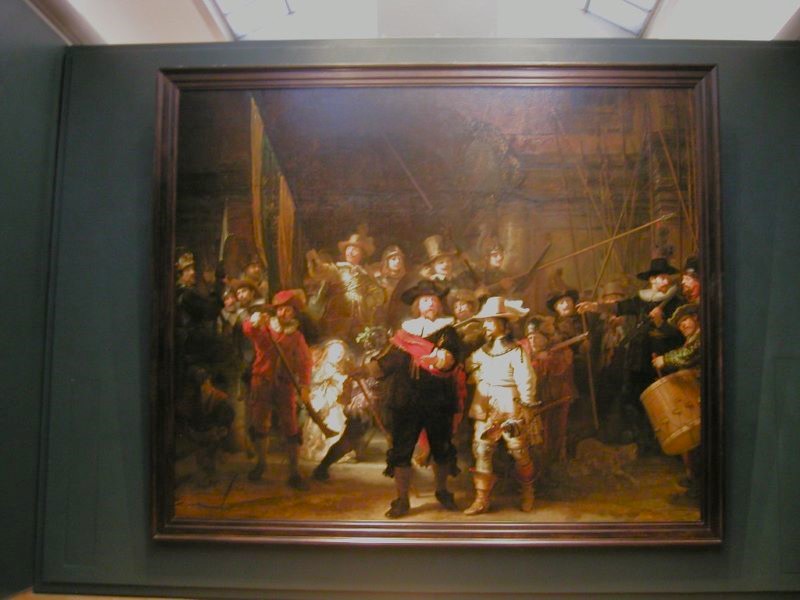
The Night Watch, Rembrandt by Joao Araujo licensed under CC BY-SA 2.0 DEED
Rembrandt van Rijn’s The Night Watch, officially titled “Militia Company of District II under the Command of Captain Frans Banninck Cocq,” is a masterpiece of light, shadow, and dynamic composition, housed in Amsterdam‘s Rijksmuseum. Completed in 1642, this painting is famous for its large scale and the lively action it depicts, far from the static militia portraits of the time. Rembrandt’s genius in manipulating light and focus brings the figures to life, with Captain Cocq and his lieutenant illuminated as if by a spotlight, creating a sense of immediacy and involvement for the viewer.
While You’re There: The Rijksmuseum’s collection invites further exploration into the Dutch Golden Age, including The Milkmaid by Johannes Vermeer. This painting, known for its exquisite play of light and detail, captures the beauty in everyday life, complementing the grandeur and complexity of The Night Watch.
The Kiss (1907), Gustav Klimt — Belvedere Palace, Vienna, Austria
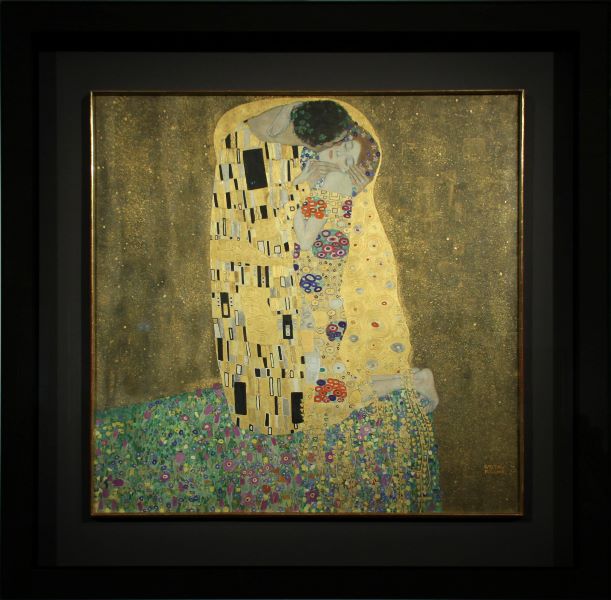
Gustav Klimt – The Kiss 1908 by Tony Hisgett licensed under CC BY 2.0 DEED
Gustav Klimt’s The Kiss, displayed in the opulent Belvedere Palace in Vienna, is a dazzling celebration of love and beauty, emblematic of the Art Nouveau movement. Completed in 1907, this painting captures an intimate moment between two lovers, enveloped in a cascade of gold and symbolic ornamentation. Klimt’s use of gold leaf not only adds a luxurious texture but also imbues the work with a sacred, timeless quality. The figures, lost in their embrace, are set against a flowery meadow, suggesting their complete immersion in the moment and each other.
While You’re There: Explore more of Klimt’s work within the Belvedere, including Judith and the Head of Holofernes. This painting offers a striking contrast to the tender intimacy of The Kiss, showcasing Klimt’s versatility in handling themes of love and beauty alongside power and vulnerability.
You Might Also Enjoy: Amazing Art Museums That Are Reason Enough to Visit a City
A Sunday Afternoon on the Island of La Grande Jatte (1884), Georges Seurat — Art Institute of Chicago, Chicago, Illinois
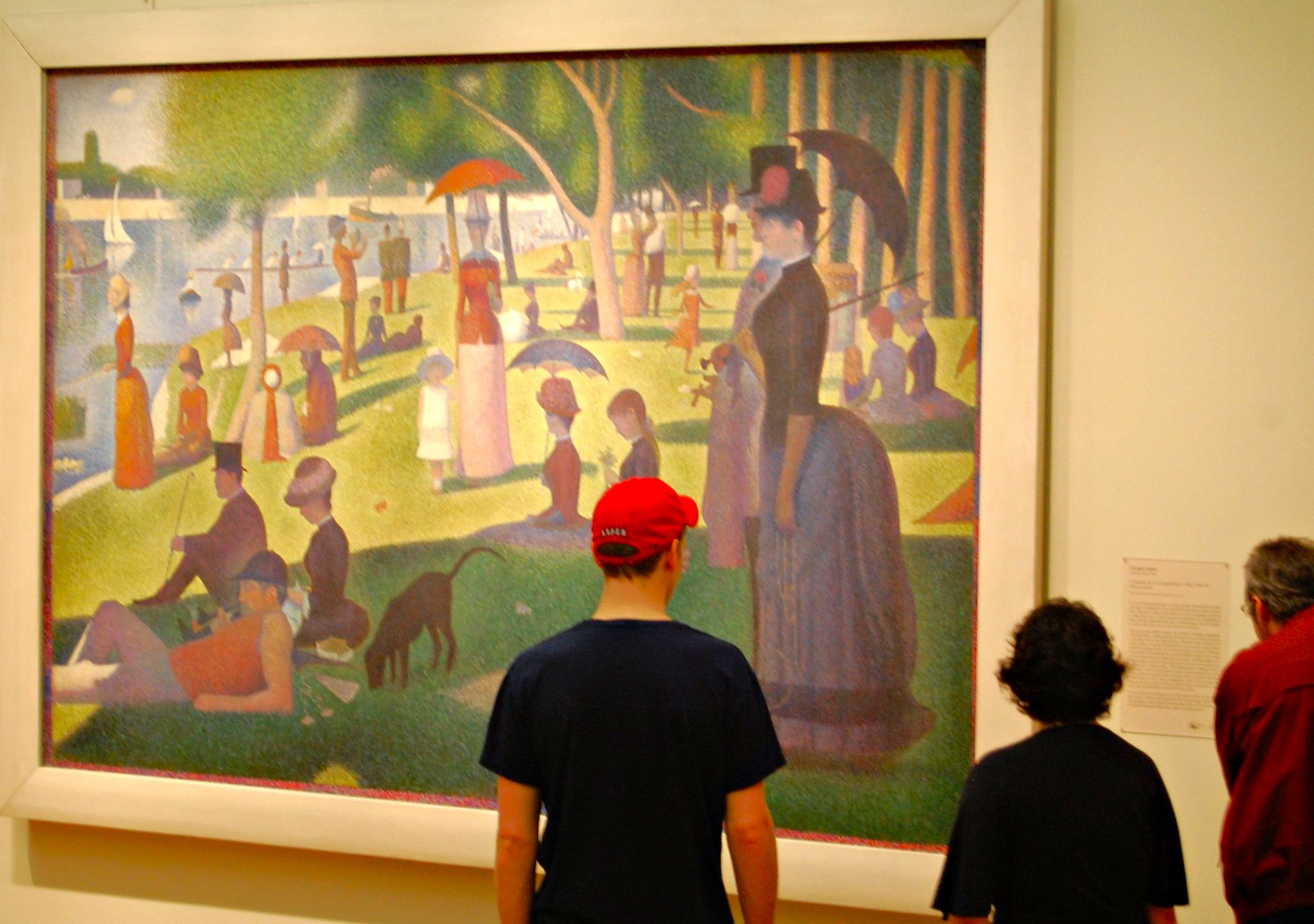
Georges Seurat, A Sunday on La Grande Jatte by JR P licensed under CC BY-NC 2.0 DEED
Georges Seurat’s A Sunday Afternoon on the Island of La Grande Jatte, showcased at the Art Institute of Chicago, is a monumental work that epitomizes the pointillism technique, which the artist pioneered. Completed in 1884, this painting reflects Seurat’s innovative use of small, distinct dots of color applied in patterns to form an image. This method gives the scene — a leisurely snapshot of Parisians enjoying a Sunday on the Seine’s banks — a vibrant, luminous quality. Seurat’s meticulous attention to the interplay of light and color captures the idyllic atmosphere of the day, making this painting a cornerstone of Neo-Impressionism.
While You’re There: The Art Institute of Chicago offers a wealth of other iconic works, including Edward Hopper’s Nighthawks, a masterful depiction of American urban solitude, and Grant Wood’s American Gothic, an enduring symbol of rural American values.
FAQs:
Q: What are the opening hours for these museums?
A: Opening hours vary by museum. Most open between 9-10 am and close between 5-6 pm. It’s recommended to check the museum’s official website for specific times, including holiday schedules.
Q: Are tickets required for all museums mentioned?
A: Yes, tickets are required. Purchasing in advance online is recommended to avoid long lines and ensure entry, especially for popular museums like the Louvre and the Rijksmuseum.
Q: Do any of these museums offer free admission days?
A: Some museums offer free admission on certain days or periods. For example, the Louvre offers free admission on the first Saturday night of each month. Check the museum’s website for such offers.
Q: Can I take photos of the paintings?
A: Photography policies vary. Some museums allow photography without flash, while others may prohibit it entirely in certain exhibits. Always look for signs or ask staff before taking photos.
Q: Are guided tours available?
A: Most museums offer guided tours, which can provide deeper insight into the artworks. Tours may be available in multiple languages. Check the museum’s website for schedule and pricing.
Q: Is there a best time of year to visit these museums?
A: While museums are open year-round, visiting during shoulder seasons (spring and fall) can mean fewer crowds and more pleasant weather, enhancing your experience.
Q: Are these museums accessible for visitors with disabilities?
A: Major museums are equipped with facilities to accommodate visitors with disabilities, including wheelchair access and sometimes free entry for caregivers. Contact the museum in advance for specific arrangements.


Leave a Reply